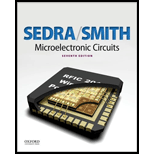
Microelectronic Circuits (The Oxford Series in Electrical and Computer Engineering) 7th edition
7th Edition
ISBN: 9780199339136
Author: Adel S. Sedra, Kenneth C. Smith
Publisher: Oxford University Press
expand_more
expand_more
format_list_bulleted
Question
Chapter 4, Problem 4.20P
To determine
The value of the current when junction voltage is changed to different values.
The value of change in junction voltage when diode current is increased by a factor of 10.
Expert Solution & Answer
Want to see the full answer?
Check out a sample textbook solution
Students have asked these similar questions
£1² = 2+ cos(5+) u(4-1)
7-
=£ (t-1+1)
2
J
-2(+-1+1)
Cas [5(4-1+1)] uct-1)
e
S
es { ((+1) = 2(4+1) cos [5 (+1)] u(+)
Please answer all
solve for the following
Chapter 4 Solutions
Microelectronic Circuits (The Oxford Series in Electrical and Computer Engineering) 7th edition
Ch. 4.1 - Prob. 4.1ECh. 4.1 - Prob. 4.2ECh. 4.1 - Prob. 4.3ECh. 4.1 - Prob. 4.4ECh. 4.1 - Prob. 4.5ECh. 4.2 - Prob. 4.6ECh. 4.2 - Prob. 4.7ECh. 4.2 - Prob. 4.8ECh. 4.2 - Prob. 4.9ECh. 4.3 - Prob. 4.10E
Ch. 4.3 - Prob. D4.11ECh. 4.3 - Prob. 4.12ECh. 4.3 - Prob. 4.13ECh. 4.3 - Prob. 4.14ECh. 4.3 - Prob. D4.15ECh. 4.4 - Prob. 4.16ECh. 4.4 - Prob. 4.17ECh. 4.4 - Prob. 4.18ECh. 4.5 - Prob. 4.19ECh. 4.5 - Prob. 4.20ECh. 4.5 - Prob. 4.21ECh. 4.5 - Prob. 4.22ECh. 4.5 - Prob. 4.23ECh. 4.5 - Prob. 4.24ECh. 4.5 - Prob. 4.25ECh. 4.6 - Prob. 4.26ECh. 4.6 - Prob. 4.27ECh. 4 - Prob. 4.1PCh. 4 - Prob. 4.2PCh. 4 - Prob. 4.3PCh. 4 - Prob. 4.4PCh. 4 - Prob. 4.5PCh. 4 - Prob. 4.6PCh. 4 - Prob. D4.7PCh. 4 - Prob. D4.8PCh. 4 - Prob. 4.9PCh. 4 - Prob. 4.10PCh. 4 - Prob. D4.11PCh. 4 - Prob. 4.12PCh. 4 - Prob. 4.13PCh. 4 - Prob. 4.14PCh. 4 - Prob. D4.15PCh. 4 - Prob. 4.16PCh. 4 - Prob. 4.17PCh. 4 - Prob. 4.18PCh. 4 - Prob. 4.19PCh. 4 - Prob. 4.20PCh. 4 - Prob. 4.21PCh. 4 - Prob. 4.22PCh. 4 - Prob. 4.23PCh. 4 - Prob. 4.24PCh. 4 - Prob. 4.25PCh. 4 - Prob. 4.26PCh. 4 - Prob. 4.27PCh. 4 - Prob. 4.28PCh. 4 - Prob. 4.29PCh. 4 - Prob. 4.30PCh. 4 - Prob. 4.31PCh. 4 - Prob. 4.32PCh. 4 - Prob. 4.33PCh. 4 - Prob. 4.34PCh. 4 - Prob. 4.35PCh. 4 - Prob. 4.36PCh. 4 - Prob. D4.37PCh. 4 - Prob. 4.38PCh. 4 - Prob. 4.39PCh. 4 - Prob. 4.40PCh. 4 - Prob. 4.41PCh. 4 - Prob. 4.42PCh. 4 - Prob. 4.43PCh. 4 - Prob. 4.44PCh. 4 - Prob. D4.45PCh. 4 - Prob. 4.46PCh. 4 - Prob. 4.47PCh. 4 - Prob. 4.48PCh. 4 - Prob. 4.49PCh. 4 - Prob. 4.50PCh. 4 - Prob. 4.51PCh. 4 - Prob. 4.52PCh. 4 - Prob. 4.53PCh. 4 - Prob. 4.54PCh. 4 - Prob. 4.55PCh. 4 - Prob. D4.56PCh. 4 - Prob. D4.57PCh. 4 - Prob. 4.58PCh. 4 - Prob. 4.59PCh. 4 - Prob. D4.60PCh. 4 - Prob. 4.61PCh. 4 - Prob. 4.62PCh. 4 - Prob. D4.63PCh. 4 - Prob. D4.64PCh. 4 - Prob. D4.65PCh. 4 - Prob. D4.66PCh. 4 - Prob. 4.67PCh. 4 - Prob. 4.68PCh. 4 - Prob. 4.69PCh. 4 - Prob. 4.70PCh. 4 - Prob. 4.71PCh. 4 - Prob. 4.72PCh. 4 - Prob. D4.73PCh. 4 - Prob. D4.74PCh. 4 - Prob. D4.75PCh. 4 - Prob. 4.76PCh. 4 - Prob. 4.77PCh. 4 - Prob. 4.78PCh. 4 - Prob. 4.79PCh. 4 - Prob. D4.80PCh. 4 - Prob. D4.81PCh. 4 - Prob. D4.82PCh. 4 - Prob. D4.83PCh. 4 - Prob. D4.84PCh. 4 - Prob. 4.85PCh. 4 - Prob. 4.86PCh. 4 - Prob. 4.87PCh. 4 - Prob. 4.88PCh. 4 - Prob. 4.89PCh. 4 - Prob. 4.90PCh. 4 - Prob. 4.91PCh. 4 - Prob. 4.92PCh. 4 - Prob. 4.93PCh. 4 - Prob. 4.94PCh. 4 - Prob. 4.95PCh. 4 - Prob. 4.96PCh. 4 - Prob. 4.97P
Knowledge Booster
Learn more about
Need a deep-dive on the concept behind this application? Look no further. Learn more about this topic, electrical-engineering and related others by exploring similar questions and additional content below.Similar questions
- Calculate de currents IaA, IbB and IcCarrow_forward7.48 Determine the Thevenin equivalent of the circuit inFig. P7.48 at terminals (a,b), given thatVs(t) = 12cos 2500t V,Is(t) = 0.5cos(2500t −30◦) A.arrow_forward1. In the following closed-loop system, a PD controller of the form K(s + 5) is used. Design the gain K such that the system achieves an overshoot of 16%. Calculate the settling time and peak time for the PD controlled system. Compensator R(s) + E(s) Plant 1 C(s) K(s+Zc) (s+1)(s+2)(s+5)arrow_forward
- Find Voarrow_forward3. Use MATLAB to generate the Nyquist plot for the following system. Then, apply the Nyquist stability criterion to determine the range of K values that ensure the stability of the closed-loop system. R(s)+ K C(s) (s+2) 1 (s + 4)(s+6)arrow_forward4. Please find the stability margins from the following Bode diagrams. Bode Diagram Phase (deg) Magnitude (dB) 50 -100 -90 -135 -180 -270 10" 10° Frequency (rad/sec) 10'arrow_forward
arrow_back_ios
SEE MORE QUESTIONS
arrow_forward_ios
Recommended textbooks for you

 Electricity for Refrigeration, Heating, and Air C...Mechanical EngineeringISBN:9781337399128Author:Russell E. SmithPublisher:Cengage Learning
Electricity for Refrigeration, Heating, and Air C...Mechanical EngineeringISBN:9781337399128Author:Russell E. SmithPublisher:Cengage Learning Delmar's Standard Textbook Of ElectricityElectrical EngineeringISBN:9781337900348Author:Stephen L. HermanPublisher:Cengage Learning
Delmar's Standard Textbook Of ElectricityElectrical EngineeringISBN:9781337900348Author:Stephen L. HermanPublisher:Cengage Learning


Electricity for Refrigeration, Heating, and Air C...
Mechanical Engineering
ISBN:9781337399128
Author:Russell E. Smith
Publisher:Cengage Learning

Delmar's Standard Textbook Of Electricity
Electrical Engineering
ISBN:9781337900348
Author:Stephen L. Herman
Publisher:Cengage Learning
Three-Phase Half-Wave Rectifier Operation; Author: katkimshow;https://www.youtube.com/watch?v=Uhbr6tbMB9A;License: Standard Youtube License